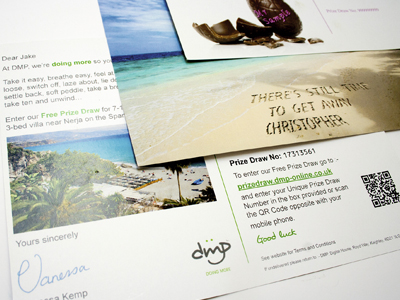Personalised direct mail campaigns like this example from DMP can be very effective – as long as you have the right data
Direct mail is enjoying something of a resurgence and impending regulation means that, done right, it will only become a more powerful medium. Michael Walker looks at what’s pushing the envelope.
The global financial crash of 2008 almost killed direct mail as marketing budgets were slashed and the mail stream dwindled to the merest of trickles. As economies slowly recovered and businesses confidence started to seep back, many directed their recovering resources into the new and exciting digital alternatives – email, the web and increasingly, mobile devices. In addition to the novelty value, these channels offered apparently near-zero distribution costs, plus the promise of personalisation and interactivity that stuffy and expensive old print couldn’t match.
Nearly a decade later, much has changed. The digital deluge is starting to face something of a backlash. Ad blockers are in widespread use by web visitors; an email spam filter is de rigeur, and even then, according to the Direct Marketing Association, 68% of consumers think that most emails are irrelevant to them. To make matters worse for email marketers, 62% of people have abandoned email addresses and 45% of consumers have “ghost” emails – accounts that are active but never checked.
Then there’s the human ability to screen out interference. ‘Millennials are absolute masters of ignoring digital stuff,’ says Roger Christiansen, a freelance trainer and consultant who has worked with major brands such as IBM.

Consultant Roger Christiansen: millennials screen out digital noise – but don’t call them that
Meanwhile, thanks to relentless development, print has been getting nimbler and cheaper. Very short run work can be turned around almost instantly and, with the right data handling and composition tools, producing personalised materials needn’t take much longer, so print can very much become part of flexible and responsive direct marketing campaigns.
Generation gap
The audience has also been getting younger. Today’s younger adults haven’t grown up in a world where “junk mail” means stuff that comes through the letterbox, lands on the doormat and is put straight in the bin. For them, getting something interesting in the post has the novelty value that embedded video in email did for their parents a decade ago. And across all demographics, mail has an open rate that digital equivalents can only dream of:
‘Our experience is that open rates for emails range from two to five per cent for a cold list and around 30% for a targeted existing client list. Now compare that to the open rate of mail being 75%,’ says Andy Barber, managing director UK Mail’s iMail operation and chairman of Prokom, Konica Minolta’s user group. ‘Mail is then passed around homes [typically] between four individuals; when was the last time you shared an marketing email?’
It looks like the stage is very much set for a direct mail comeback, and this does seem to be happening. The 2016 DMA Response Rate report shows that response rates are at their highest level since 2003, and Linda Furniss, marketing executive at Keighley, West Yorkshire-based DMP quotes Royal Mail reports that show that significantly more consumers now say mail gets their attention than did in 2007. The number of people that spend “a lot of time” reading it is also up by 10% and some 57% say that receiving mail makes them feel more valued, up by a third.

Andy Barber of iMail – bucking the trend with 50% year-on-year DM growth
Mr Barber can put his own company’s numbers to the trend. ‘We are seeing a definite increase in direct marketing activities from our core SME customers, particularly campaigns blended with digital channels, with our overall volume being close to 50% up year-on-year,’ he confirms. He accepts that this is in contrast to the broader market trend of a four-to-six per cent decline in overall mail communications, but sees ‘significant growth opportunities for DM, providing it is timely, cost effective and measurable – which are all core elements of digital marketing channels.’ He also says that iMails’s new customers include recent entrants to the marketing profession who have only ever used digital channels.
Do as digital does
The key here is to bring digital values to the print medium, so it’s not a digital-versus-print discussion but one which harnesses the strengths of the different channels in tandem. Linda Furniss suggests that direct mail has reached its “proper place” as the driver of coordinated campaigns which draw customers into the online world: ‘DM now drives a digital coordinated campaign which is powerful, personal and leads to purchase,’ she believes.
Birmingham-based high volume mail specialist Bakergoodchild reports that although print volumes are “not returning to the highs of previous years”, print is increasingly being used by its clients as part of cross-media campaigns in which it’s used either as an introductory medium or as a way of targeting visits to websites or other online media.

Sorted: as well as personalised printing, getting jobs mail-ready is a key requirement that has a critical influence on cost
iMail’s Andy Barber agrees but stresses the continuing importance of marketing fundamentals such as a thought-provoking creative approach, good copywriting, timely delivery and of course, talking to the right audience, coupled with a strong sales operation. He also points to the physical properties of print, saying ‘You cannot digitise the sensory experience and anticipation of opening a mail item, so I think it much more important now for marketers to combine digital channels with print.’
Tech toolkit
Short run, personalised and highly targeted mail campaigns are one of the things that digital presses are made for, and mail-handling finishing and inserting lines aren’t a new idea either, so it’s perhaps no surprise to find that the areas direct mail printers focus on aren’t in the print and finishing halls. Mr Barber, whose firm uses Konica Minolta Bizhub C1100 presses linked to an EFI workflow, says that they had to build their own mail software to meet their clients’ needs. ‘It’s not “one size fits all”, people produce mail in many different ways – financial clients might provide just raw data, for example, but we’ve also seen a big step up in inserts with transactional mailings,’ he explains. He also sees room for improvement in media planning tools that can measure reach and distribution better.
While the iMail system provides web interfaces and standard file transfer options, the composition process of getting jobs both print- and mail-ready is done by their bespoke software. Bakergoodchild, which uses Xerox presses, sees data acquisition as the main challenge, in order to have the most up-to-date and relevant information for marketing purposes. Linda Furniss at DMP also regards data as the key challenge, and despite having produced successful personalised mailing for clients who have that data, feels that there is still potential to progress this further.
Collecting and using this kind of customer data will become much more tightly regulated thanks to the arrival of GDPR in May 2018 (see box-out), and while much has been made of the steep penalties it may impose, the upside is that if properly followed, compliance with the new terms should actually be a competitive advantage for marketers and their print suppliers, as they will be dealing with customers or prospects who have clearly indicated and confirmed their interest. Bakergoodchild says that ISO 27001 accreditation for data security is a useful advantage and suggests that print is “likely to become the easier medium by which companies communicate with their customers”.
Add in the capabilities now arriving for digital enhancement of personalised and very short run print, and it looks like the future for direct mail may be rosier than anyone could have predicted a decade ago.
What is GDPR?
These initials have been striking fear into the hearts of some in the marketing world because penalties for non-compliance can be four per cent of global turnover or €20 million, but the General Data Protection Regulation is aimed at giving consumers better control of how their data is gathered and used. Although it’s an EU regulation, it’s Brexit-proof because it will come into effect on 25 May 2018, and even after the expected March 2019 exit, its requirements, like much EU legislation, will still affect UK businesses.
It can be viewed as either an evolution of or a replacement for the Data Protection Act 1998, which as Roger Christiansen points out, was drafted long before social media and smartphones were invented. As well as aiming to harmonise consumer data protection across the EU, it aims to address issues of consent and control over consumers’ data that have arisen in the interim.
One of the key points is that anyone in the supply chain is potentially liable if a data “breach” (unauthorised access) occurs, or if the explicit consent for use of data for clearly specified purposes isn’t gained, so direct marketing providers and printers need to be aware, especially in multi-channel campaigns where it’s not always clear who the “data controller” is. Kevin Pembroke, owner at Distinct Communications, advises a three-stage approach: a readiness assessment to identify what data is held and how it’s processed; a gap assessment to plan breach procedures and how to handle deletion requests; and a privacy impact assessment that should precede any new campaign and consider how consumer data will be handled.

Kevin Pembroke: new regs bring a lot more power to the individual but that should help buld trust
Mr Pembroke says that some areas are still under intense discussion and it’s not absolutely clear right now whether B2B communications will be included or not – there is a “legitimate interest” argument – but anything that deals directly with consumers certainly will be, so better safe than sorry.
Read the full September issue of Digital Printer here. Subscribe to the magazine for free – register your details here.





